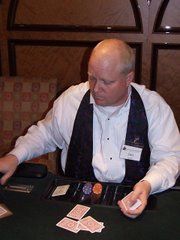 On my third day at the WSOP, I started out in the pot-limit holdem event. I enjoy playing pot-limit, which I think is a better game than no-limit, and after learning a few tricks at dealer school, the math is no longer much of a challenge. I get a kick out of anticipating the lesser experienced players bids to "raise the pot" and have an instant answer as to the amount they can make the bet. When you are able to do this, most of the players who might otherwise try to be table captains, lay back and give you respect (or at least the latitude necessary to carry on without them).
On my third day at the WSOP, I started out in the pot-limit holdem event. I enjoy playing pot-limit, which I think is a better game than no-limit, and after learning a few tricks at dealer school, the math is no longer much of a challenge. I get a kick out of anticipating the lesser experienced players bids to "raise the pot" and have an instant answer as to the amount they can make the bet. When you are able to do this, most of the players who might otherwise try to be table captains, lay back and give you respect (or at least the latitude necessary to carry on without them).Unfortunately, I received a table assignment that I would soon consider the worst in the building. Some folks complained about the players pavilion, a temporary tent-like structure behind the Rio convention center. But pitching cards out there was a breeze compared to the half dozen tables along the back corner of the cash game area. The giant Amazon room is divided into four quadrants. The largest area contained 64 tables used for the tournament events. Up front of that area, there were another 20 tournament tables in a quadrant dominated by the main table stage. The quadrant in front of the cash cage had about 40 tables which were primarily used for single table satellites. The quadrant behind it, had another 40 tables designated for cash games. During the large saturday no-limit holdem events, all of the tables in the Amazon room would start out being used for the tournament, as well as overflow areas (60+ tables in the pavilion, 13 tables in the hallway outside of Buzio's seafood restaurant, another 10 tables in the year-round poker room). After all event alternates are placed, they start breaking a few tables in the cash game area, then a few in the satellite area to accommodate players who want that action. Usually the overflow area players remain in those locations until they play down to a couple of tables, which are moved into the Amazon tournament area. The cash game quadrant tables have permanent cast boxes with locking lids, so that the dealers bank can be secured without dealers or floormen having to handle/transport those cash games chips. When used for the tournament events, you have to deal over the locking lid and you can not use the box for any of the housekeeping items you need, such as the alternate deck, seat cards, down card, players receipts, etc. It is a hassle finding space to store these items because the table also has a slide for the rake drop. Further, the tables in the back of this quadrant are the least used in the room, so broken equipment and chairs get pushed to them. A few of the dealers chairs in this area were missing legs or casters and either rocked or slanted, and none of them adjusted to an appropriate height, which made working over the locked lid quite a challenge. At times it felt the table was at about shoulder level.
In all, I got nine tournament downs, most of them on the no-man's land tables. Players of note that were at my tables included: John Juanda, John Friedberg, Roland de Wolfe, Michael Gracz, Jeff Madsen, Scott Clements, Michael Binger and Amnon Fillippi. I also dealt to Tom Schneider, a Dallas area player who contributes to the Pokerati weblog, and went on to win this event and his first WSOP bracelet. He also went on to win event #46, accumulated the most player points during the series to capture the Milwaukee's Best Light Player of the Year award, and ended the year in the top ten of most of the POY ranking lists.
After my tourney downs the previous day, I was directed to go to the cash area and was assigned to the biggest game in the high-limit section. But, by the time they converted me over to that paycode on the time clock, the swing shift dealers were filling in and I was told to go home. On this day, however, I was able to stay late and got my first few cash game downs. In cash games, you keep your own tips, so I was excited about this, even though the main reason I came to Vegas was to deal the tournaments. Unfortunately, I sat in a dead spread for almost two full downs. You make no tips, of course, if there are no players at your table. Then I dealt $2-5 NL Holdem (the smallest game spread), $5-10 NL Holdem, $15/30 Limit Omaha 8 with a 1/3rd kill, and $20/40 Limit Holdem. My tips over those three hours were a little lighter than I anticipated, but I always strive to maintain the attitude that no tip is expected and every single dollar is appreciated.







No comments:
Post a Comment